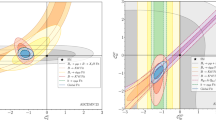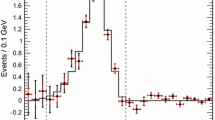Summary
It is shown that Kim and Primakoff’s suggestion that second-class axial vector currents are present in the semi-leptonic weak Hamiltonian leads toT-violating effects in π+→ℓ+vℓγ. Using Maiani’s model for these currents and dominating them by the B-meson, we estimate the size of possibleT-violating effects. Theoretical predictions are compared with current experimental evidence.
Riassunto
Si dimostra che il suggerimento di Kim e Primakoff che le correnti vettoriali assiali della seconda classe siano presenti nella hamiltoniana debole semileptonica porta a risultati che violanoT in π+→ℓ+vℓγ. Usando il modello di Maiani per queste correnti e dominandole col mesone B, si calcola l’ordine di grandezza degli effetti che violanoT. Si confrontano le previsioni teoriche con i dati sperimentali sulle correnti.
Реэюме
Покаэывается, что предположение Кима и Примакова о том, что аксиально-векторные токи второго класса присутствуют в полулептонном слабом Гамильтониане, приводит к Эффектам T-нарущения в π+→ℓ+vℓγ. Йспольэуя модель Майани для Этих токов и их доминантность, благодаря В-меэону, мы оцениваем величину воэможных Эффектов Г-нарущения. Теоретические предскаэания сравниваются с Эксперинментальным подтверждением токов.
Similar content being viewed by others
References
C. W. Kim andH. Primakoff:Phys. Rev.,180, 1502 (1969).
M. T. Burgy, V. E. Krohn, T. B. Novey, G. R. Ringo andV. L. Telegdi:Phys. Rev.,120, 1829 (1960).
This feature has been previously pointed out byN. Cabibbo, ref. (1).
L. Maiani:Phys. Lett.,26 B, 538 (1968).
B. R. Holstein:Phys. Rev.,177, 2417 (1969).
J. L. Gervais, J. Iliopoulos andJ. M. Kaplan:Phys. Lett.,20, 432 (1966).
S. Weinberg andH. Schnitzer:Phys. Rev.,164, 1828 (1967).
S. Brown andG. West:Phys. Rev.,168, 1605 (1968).
S. Brown andG. West:Phys. Rev.,174, 1777 (1968).
J. D. Bjorken:Phys. Rev.,148, 1467 (1966).
As shown in ref. (10), vanishing of the second of these commutators is assured in the quark model, since it possesses isospin zero, and in the usual algebra of fields, wherein the chiral symmetry breaking part of the Lagrangian is minimal in that it does not depend onF a µv =∂µV a v − ∂vV a µ .
S. Weinberg:Phys. Rev. Lett.,18, 507 (1967).
S. Brown andG. West:Phys. Rev.,180, 1613 (1969).
P. Horwitz andP. Roy:Phys. Rev.,180, 1430 (1969).
We have defined, as in ref. (15).
J. Ballam, A. D. Brody, G. B. Chadwick, D. Fries, Z. A. T. Guiragossián, W. B. Johnson, R. R. Larsen, D. W. G. S. Leith, F. Martin, M. Perl, E. Pickup andT. H. Tan:Phys. Rev. Lett.,21, 934 (1968).
K. Kawarabayashi andM. Suzuki:Phys. Rev. Lett.,16, 255 (1966).
J. S. Vaishya:Phys. Rev.,173, 1757 (1968).
The vanishing of the latter commutation relation is again based on a minimal coupled model, as explained in ref. (12). Such a result must follow if we impose strict PCAC, so that∂µAµ behaves as a canonical field.
A Rosenfeld:Rev. Mod. Phys.,40, 77 (1968).
From ref. (22), we haveΓB→πρ/ΓB→πω < 1.5%.
S. Brown andG. West:Phys. Rev.,174, 1777 (1968).
V. G. Vaks andB. L. Ioffe:Nuovo Cimento,10, 342 (1958).
D. Neville:Phys. Rev.,124, 2037 (1961).
G. von Dardel, D. Dekkers, R. Mermod, J. D. Van Putten, M. Vivargent, G. Weber andK. Winter:Phys. Lett.,4, 51 (1963).
P. Depommier, J. Heintze, C. Rubbia andV. Soergel:Phys. Lett.,7, 285 (1963).
Author information
Authors and Affiliations
Additional information
Research supported by the Air Force Office of Scientific Research under contract AF 49 (638)-1545.
Rights and permissions
About this article
Cite this article
Holstein, B.R. The B-meson andT-violation in radiative π decay. Nuovo Cimento A (1965-1970) 68, 369–382 (1970). https://doi.org/10.1007/BF02758133
Received:
Published:
Issue Date:
DOI: https://doi.org/10.1007/BF02758133




